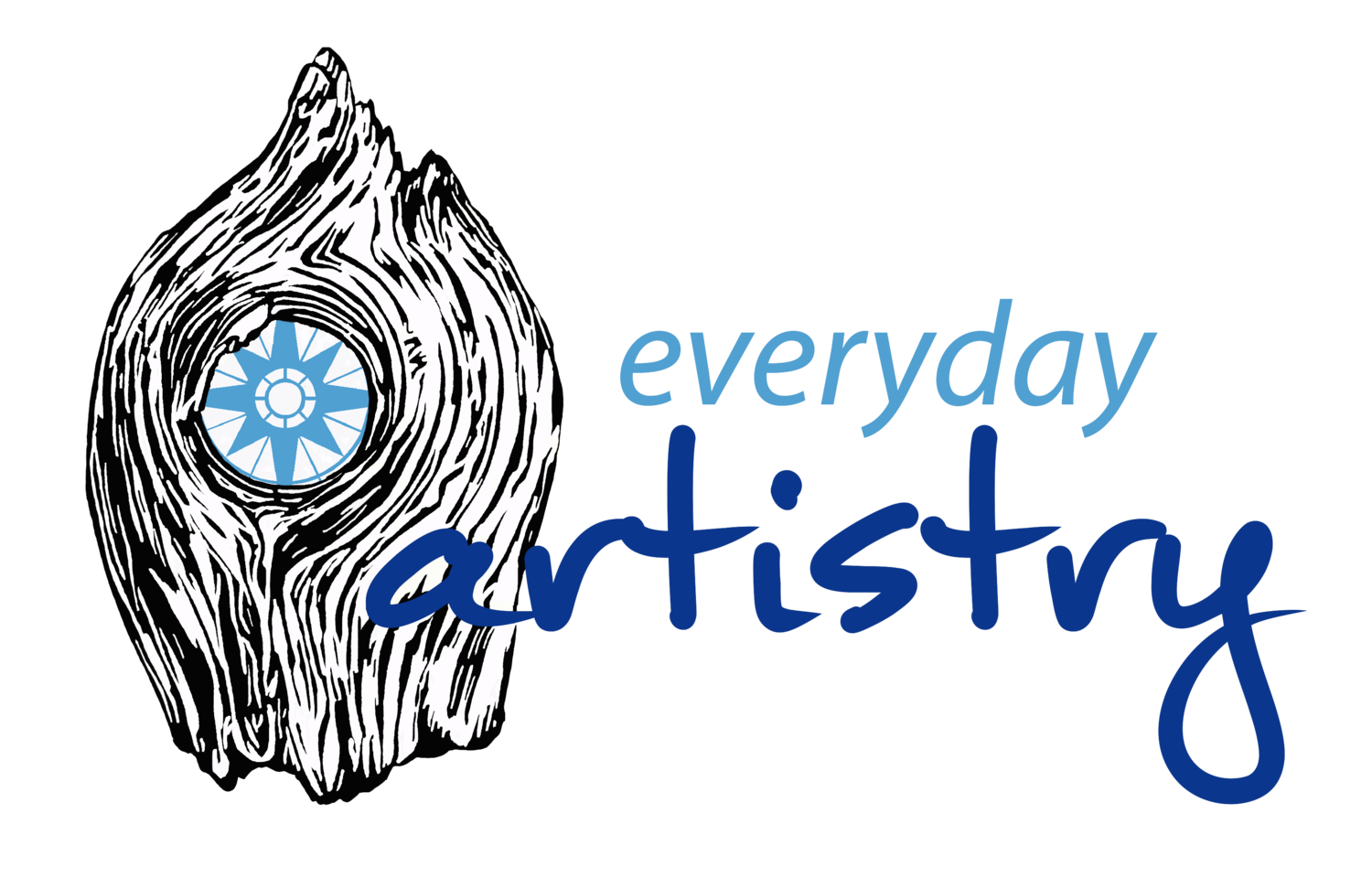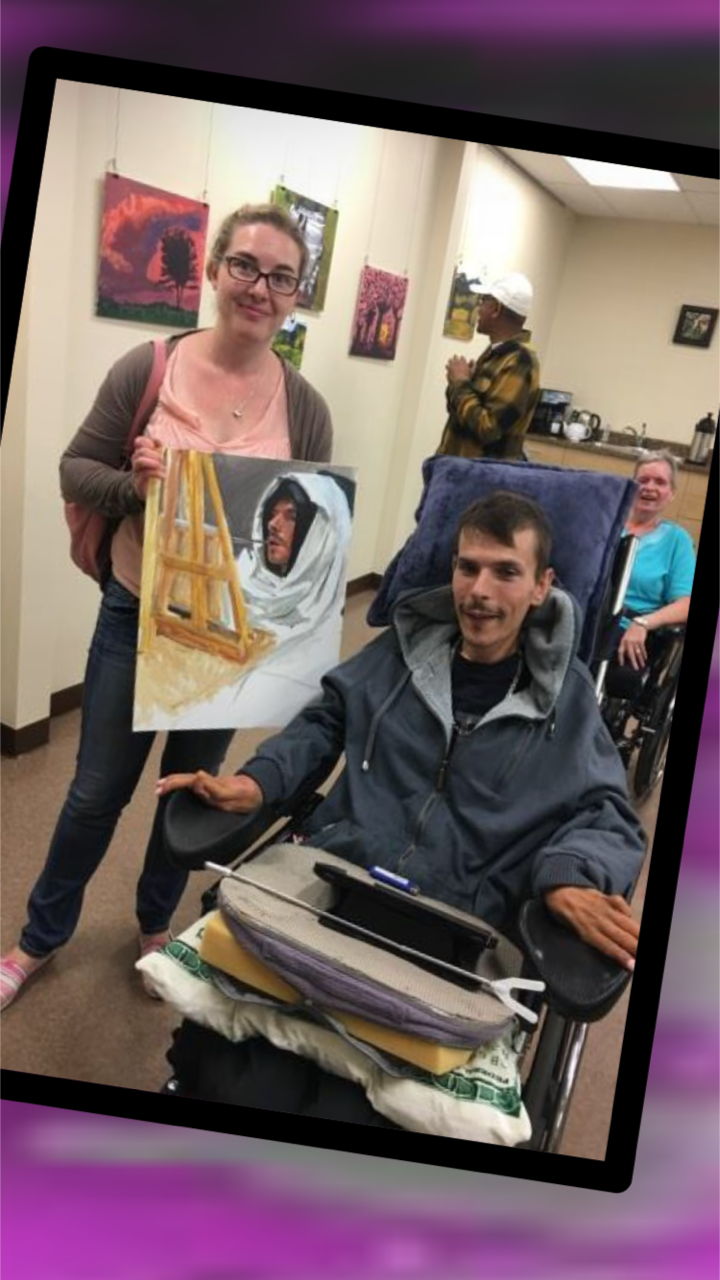One of my favourite ways to stay inspired is to read about how other people put their creativity into practice and learn to live creative lives. Every so often, I’ll be interviewing someone who is letting their creative light shine. Hopefully, these folks will inspire you as much as they inspire me.
I met Daphne when I started teaching classes at Edmonton's The Paint Spot, where she also teaches. We realized that we were both from the same small town and that we had both won a banner-painting contest in that town in separate years. Her figure paintings are incredible and it's been great getting to know someone who makes a full-time living as a fine-artist.
What sort of creative work do you do?
I am a professional fine artist who primarily paints figurative work for galleries, commissions, and public art works. I am also a fine art instructor. I dabble in all genres and most 2D materials as a way to help inform my figurative work. I am well versed in oil, acrylic, gouache, and watercolour painting as well as pencil, charcoal, conte, and other various drawing materials.
Have you always thought of yourself as a creative person? Why or why not?
Yes, I have always thought of myself as a creative person for two reasons. The first was that I was raised to look at how things were made and taught that I could do anything. Both of my parents are very creative people who surrounded their kids with materials to create with. The second is that I was constantly getting positive reinforcement for my creative projects as a kid. I love working on art projects because it has always made me feel centred and it was something that I have constantly found fascinating.
How did you get started?
I received my first paid contracts to create art pieces when I was a young teenager at 13 years old. I also entered and won several art competitions. As a child I didn’t quite understand that being an artist could be a career choice because I didn’t see anyone around me or in my community that I considered a very successful artist that I could model, people interested in the arts just practiced as a hobby. Doctors, lawyers, teachers, and other professionals have fairly clear career paths, but artists are trend setters and entrepreneurs (artrepeneurs) that often create independent new paths and no two artists follow the same creative or business practices. I feel that I was open to opportunities and new experiences and was often given them having my young age over looked because of the technical skills I lovingly cultivated.I took every art class I could, I have read every artist biography and art book I could get my hands on, and met everyone in my community with technical fine art skills and asked them all the questions I could. Then I went to the University of Alberta and received my BFA. During that time I started to instruct art classes privately, and started to increase the amount of commissions, gallery shows, and other art endeavours. Currently, I am still educating myself by seeking out the global art community. I travel to study art works in museums, galleries, and other locations, as well as to study from internationally recognized artists.
What is your process like?
First I have a reason to create, often for a show, a competition, or a patron. Deadlines are important are often a great motivator to completing work. The individual pieces themselves or a series of work starts with an idea, usually inspired by the world around me and visual experiences I’ve had. Then the size of the work is determined. Then I will do some sketching in my sketchbook to work out the technical and compositional issues of creating the work. Then I coordinate a session with models or the subject to collect photographic reference material, or plan out the session if painting from life. After collecting photo reference materials I go through and make more compositional and colour studies digging out the elements that are the most important to me such as mood and personality or spirit of the figure. Often if it is just a quick project I will just do the studies in my head, it’s kind of like figuring out mathematical problems, when you do so many so often after a while you can start to do it in your head, but for paintings that have new elements that I’ve never come across before I work it out on paper first. Then I turn up the music on my noise canceling headphones and get to work.
I often work on up to 5 paintings at one time so that I can bounce around and keep a fresh perspective, staring at the same painting for more than three hours often causes me to make mistakes. Most of my work is created using oil paint where I use walnut oil and gamsol. I draw on the composition free hand with paint usually a warm brown or local colour, or sometimes I block in larger areas first, or both. I like to experiment and feel that every painting requires it’s own way of being created. I don’t believe there is a set rule in creating a painting. That is probably why I always feel my next painting will always be better than the last and that is probably why I am so engaged and invested in my work, because I am constantly on a search to learn new things about what I do. I don’t consult with patrons during the creating process, though I often document it on social media and I do get people I trust to come and critique my work. Most of the people I get to critique my work have no formal training or background in fine arts. Then, when I’m satisfied with the work, I varnish it, document it, and sometimes frame it, and send it off into the world.
What or who inspires you?
Light in Life and the world around me inspires me.
I am also inspired by other artists such as Bouguereau, Tulouse-Latrec, Chuck Close, Cicily Brown, Ali Cavanaugh, Jeremy Mann, Cesar Santos, Thayer, and Javier Marin.
My number one inspiration that I learned about as a child and have studied the life and career of Picasso. I considered Picasso to be one of the most successful artists of his time and possibly history. One of the most important things he did in his life long career was how he learned all the technical skills of painting and then turned them on their head to say something that mattered at a time when the world needed it. The second most important aspect of his career was how he created his own practice that paid for more than just his bills and how he lived a long full life. Lastly he saw how important it was to date his prolific body of work and seeing it as a recorded diary of an artists life. Picasso never stopped and he gave it his all.
Currently the top painting that moved me to tears is a portrait of Christopher Reeve in the National portrait gallery by artist Sacha Newley, this painting completely caught me off guard. It is unexpected and a great example of how art truly has to be experienced in person.
What’s your biggest creative struggle and how are you coping with it?
Time management. Getting enough sleep and exercise so that when I paint I can do my best. I have hired people so I can delegate tasks to people who can do them better and faster than me so I have more time to sleep, take care of myself, and create in a more focused way.
What's your #1 tip about everyday creativity?
I can’t help it I am an artist so I have to break the rules and have 2 tips:
#1. Be open to opportunities, especially the ones that challenge you, over ride fears and just say yes and do it, you’ll surprise yourself. The worst that can happen is that you fail and learn something, so no matter what you gain something, when you do nothing, you gain nothing.#2 Take and use a sketchbook everywhere! Use it for notes or drawings of things that inspire you and put it next to your bed in case an idea is bothering you before bed and jot it down and let it go because you know it’s in the sketchbook. If you wake up with the craziest dream that sparked the most amazing compositional pattern you can doodle it down. It can act as a diary and document your process for historians. If you want to become a notable artist start living like a notable artist, people will take you and your work more seriously when you take you and your work more seriously. I love looking at other artists sketchbooks.
What are you working on next?
I am currently finishing a self portrait for competitions and a 4x16 foot Youth Mural for the Town of Stony Plain’s mural collection.
My next project that I’m really excited about is a series/collection of portrait paintings I’m creating of the residents of the Westview Hospital Continuing Care Centre. This is a part of a self initiated and directed artist residency I’ve created for myself. The idea for this residency and body of work sparked when I was contracted to instruct a 5 week acrylic painting class to 6 of the residents. There were problems and opportunities that happened during the class that I noticed and felt deeply about. A major problem was that a structured 1.5hr weekly class doesn’t consistently work for people with illness and disabilities as they sometimes have bad days, a lack of stamina to participate through a whole class, they often have doctors appointments that conflict with class times.
The opportunities that their participation in an art class created was grounds for them and their community to focus on something other then their physical bodies. Creating art made all of the people in the Continuing Care Centre, from the residents, staff, family, friends, and volunteers connect together as human beings with value and displaying and engaging everyone that these people face great adversity and that we have much to learn from them. When the residents are given the opportunity they wish nothing more than to contribute to the world around them and to be seen as people. By creating these portraits with my in depth skills of depicting emotion and a person’s essence, I am creating a body of work that demonstrates that everyone is different and everyone is important.
My goal is to inspire ideas of inclusion in our communities. They are not to be hidden away and frightened of but seen for what they can do and what they contribute to our community and honoured for their strength and perseverance. They are an inspiration too often over looked.
Where can we find you online?
Website: www.daphnecote.com
Instagram: @daphnecoteartist
Twitter: @daphnecoteart
Facebook: www.facebook.com/DaphneCoteArtist





